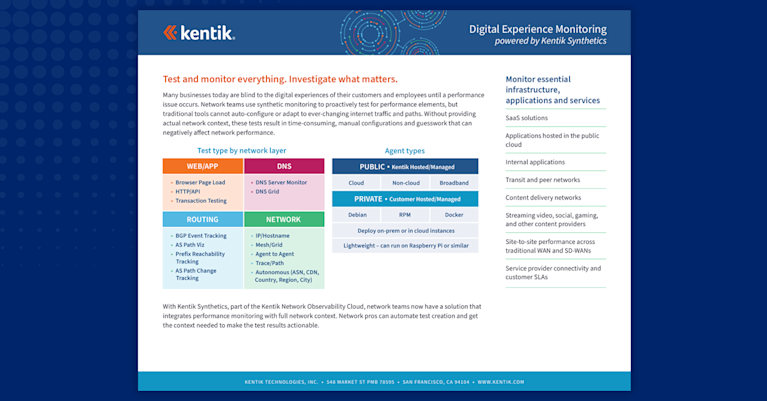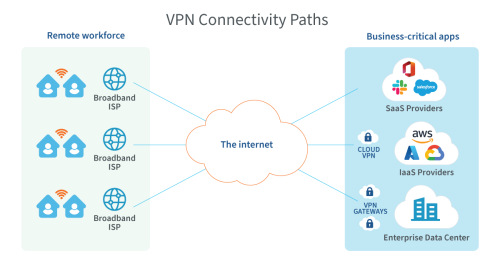Synthetic Monitoring vs Real User Monitoring (RUM)
In the world of digital experience monitoring, two key methodologies are often used to ensure optimal performance and user experience: Synthetic Monitoring and Real User Monitoring (RUM).
These two complementary approaches provide unique insights into network, application, and service performance. In this article, we’ll explore the differences between RUM vs Synthetic Monitoring and discuss how they work together to create a comprehensive monitoring strategy.
What is Synthetic Monitoring? Proactive Performance Tracking
Synthetic monitoring is an active form of monitoring that involves simulating user requests to network-accessible resources and measuring availability, response time, and other performance metrics. Synthetic monitoring builds Key Performance Indicators (KPIs) based on collected metrics by generating various types of traffic and sending it to specific targets. These tests are automatic and conducted at regular intervals to ensure applications and services continue to perform as expected.
How does Synthetic Monitoring Work?
Synthetic monitoring programmatically emulates user behavior and interactions with a website or application. It uses virtual robots or agents to perform predefined sequences of actions as a user would. Here’s a detailed breakdown of how synthetic monitoring functions:
-
Setting Up Test Scenarios:
- Before initiating synthetic tests, you must define specific scenarios the agents will follow. These scenarios could be simple, like loading a webpage, or complex, such as navigating through an e-commerce website, adding products to a cart, and completing a purchase.
-
Deployment of Test Agents:
- These agents can be deployed in various geographic locations, ensuring that performance metrics are collected from multiple vantage points. This geographic diversity offers insights into location-specific performance discrepancies and helps identify regional bottlenecks.
-
Simulating User Requests:
- Once deployed, these agents begin testing by sending simulated user requests to the target application or website. This could be as straightforward as requesting a webpage or as intricate as completing multi-step transactions.
-
Generating and Measuring Traffic:
- Based on the test scenarios, the agents generate specific types of traffic, such as HTTP requests, API calls, or even database queries. As they interact with the website or application, they meticulously measure various performance metrics like load times, response times, error rates, and more.
-
Data Collection and Analysis:
- All data generated during the synthetic tests is sent back to a centralized system. This data is then processed, analyzed, and transformed into actionable insights, forming the basis of Key Performance Indicators (KPIs). These KPIs serve as a standard against which actual user performance can be gauged.
-
Regular Interval Testing:
- Synthetic monitoring isn’t a one-off task. Instead, tests are scheduled at regular intervals, be it hourly, daily, or weekly, to ensure continual and consistent performance tracking. Some synthetic monitoring solutions, such as Kentik’s, even offer sub-minute testing intervals. This regularity helps organizations spot potential issues before they escalate into major challenges affecting real users.
-
Alerting and Reporting:
- If the monitoring detects any anomalies, like performance dips below acceptable thresholds or unexpected errors, it automatically triggers alerts. These alerts can be configured to reach the relevant stakeholders, ensuring swift action. Additionally, periodic reports can be generated to provide an overview of application or website performance over time.
By providing a controlled environment where specific user actions can be replicated consistently, synthetic monitoring allows organizations to preemptively identify and rectify potential problems, ensuring a seamless user experience.
Benefits of Synthetic Monitoring
Synthetic monitoring offers many advantages that enable organizations to maintain peak performance and deliver exceptional user experiences. Key benefits of synthetic monitoring include:
- Performance validation across various network, web, and application components
- Establishing baseline benchmarks for expected behavior under normal conditions
- User-specific testing based on roles or geographic locations
What is Real User Monitoring (RUM)? Passive User Experience Analysis
Real User Monitoring (RUM) is a passive form of monitoring that involves capturing and analyzing each user transaction or interaction with an application. RUM tracks and monitors actual application usage, recording what happened after the fact. By monitoring authentic user interactions, RUM provides insights into the user experience, helping identify potential bottlenecks or areas for improvement.
How does Real User Monitoring Work?
Real User Monitoring (RUM) offers visibility into the actual experiences and interactions of end-users with a website or application. Unlike Synthetic Monitoring, which emulates user interactions, RUM collects data from real users in real time. Here’s an in-depth look at how RUM functions:
-
Data Collection through JavaScript Tags:
- To initiate RUM, JavaScript tags or snippets are integrated into the web pages of the target application or website. These tags act as listeners, capturing data whenever a real user interacts with the site.
-
Real-time Monitoring:
- As users navigate the website or application, the JavaScript tags record each transaction, action, or interaction. Everything from page load times, mouse clicks, scrolling behavior, and even errors encountered by users might be captured in real-time.
-
Segmentation and Filtering:
- The collected data can be extensive, especially for high-traffic sites. Hence, RUM solutions often segment this data based on criteria like geographical location, device type, browser, and user behavior. This segmented view aids in pinpointing specific issues or trends.
-
Analysis of User Interactions:
- All the passively collected data is then analyzed to discern user experience patterns. Metrics such as average load time, bounce rates, session duration, and conversion rates are extracted to provide a holistic view of user satisfaction and areas of potential friction.
-
Spotting and Addressing Bottlenecks:
- By monitoring real user interactions, RUM can identify performance bottlenecks or challenges that might go unnoticed in synthetic tests. For example, a specific mobile device or browser combination might be experiencing higher load times. RUM will highlight these specific scenarios for optimization.
-
Visualization and Dashboards:
- The raw data from RUM is processed and often presented in intuitive dashboards and visualizations. This lets stakeholders quickly gauge overall website or application performance and dive deep into anomalies or trends.
-
Passive yet Insightful:
- It’s essential to understand that RUM doesn’t actively interfere with or interrupt the user experience. It silently observes, ensuring that insights into user behavior and experiences are genuine and unaffected by external monitoring forces.
Real User Monitoring offers invaluable insights into how a website or application performs in the real world by focusing on genuine user interactions. This passive monitoring approach ensures businesses receive a transparent view of user experiences, enabling them to optimize accordingly.
The definitive guide to running a healthy, secure, high-performance network

Benefits of Real User Monitoring
Key benefits of Real User Monitoring include:
- Understanding actual user experiences and behavior
- Identifying performance issues that impact real users
- Gaining insights into application usage patterns and trends
Synthetic Monitoring vs Real User Monitoring: A Comprehensive Strategy
While synthetic monitoring and RUM each offer valuable insights, they could be even more effective when combined in a comprehensive monitoring strategy. Synthetic monitoring proactively tracks performance and health, allowing organizations to catch potential issues before they impact users. On the other hand, RUM provides a real-world perspective on user experiences, helping to identify areas for optimization.
By combining both active and passive monitoring approaches, organizations can improve and optimize the end-user digital experience, ensuring that applications and services perform at their best for all users.
Synthetic Monitoring vs Real User Monitoring for Complex Web Applications
Complex web applications often require multiple components and infrastructure to function seamlessly, making monitoring their performance and availability important. Synthetic and real user monitoring (RUM) play significant roles in understanding and optimizing the user experience. Here’s a comparison of how they would be used in the context of monitoring a complex web application:
Synthetic Monitoring
Synthetic monitoring employs automated, proactive tests that simulate user interactions with the web application. These tests can help identify issues before they affect real users. In the context of complex web applications, synthetic monitoring can be used to:
-
Test critical user interactions: By simulating multi-step transactions like user login, product search, adding to cart, and checkout, synthetic monitoring can ensure that all critical components of the application are functioning as expected.
-
Measure performance across geographies: With geographically distributed test agents, synthetic monitoring can help identify performance bottlenecks and latency issues specific to different locations.
-
Monitor API endpoints: Automated tests can be created to monitor the availability and performance of essential API endpoints, ensuring that the underlying services and data needed by the web application are functioning correctly.
-
Establish baselines and set alerts: Synthetic monitoring helps establish performance benchmarks for various application components. Alerts can be set up to notify teams when performance drops below acceptable thresholds.
Real User Monitoring (RUM)
RUM passively collects performance data from actual users as they interact with the web application. This helps gain insights into the real-world user experience. In the context of complex web applications, RUM can be used to:
-
Analyze real user experience: RUM provides insights into how actual users experience the web application, including load times, response times, and resource usage.
-
Identify user-specific issues: RUM can help identify problems specific to certain user groups, devices, or browsers, which synthetic monitoring may not be able to replicate.
-
Optimize content delivery: By analyzing the performance of various resources (images, JavaScript, CSS) loaded by actual users, RUM can help optimize content delivery for a better user experience.
-
Measure the impact of changes: RUM allows monitoring of the effects of changes to the application (e.g., code updates, new features) on the actual user experience.
So, synthetic monitoring is helpful for proactively identifying potential issues and ensuring that all components of a complex web application are functioning correctly. On the other hand, Real User Monitoring provides valuable insights into the application’s real-world performance and user experience. Combining both monitoring approaches helps gain a comprehensive understanding of the web application’s performance and user experience, enabling continuous improvement and optimization.
Network Monitoring: Synthetic Monitoring vs Real User Monitoring
Network monitoring involves observing and managing the performance and availability of an organization’s computer networks, ensuring that the underlying infrastructure can support applications and services. While synthetic monitoring is commonly used in network monitoring, RUM could still offer valuable insights. Here’s an overview of their applications in network monitoring:
Synthetic Monitoring
Synthetic monitoring is particularly effective in network monitoring due to its proactive, scheduled testing approach. Key applications of synthetic monitoring for network monitoring include:
-
Proactive network performance checks: Synthetic monitoring can be used to proactively test network performance by simulating network traffic, generating requests to internal or external services, and measuring response times.
-
Network latency and packet loss detection: By sending synthetic packets between different points in the network, synthetic monitoring can help identify latency issues, packet loss, and other network performance problems.
-
Monitoring network devices: Synthetic monitoring can be employed to monitor the availability and performance of network devices such as routers, switches, and firewalls by sending periodic requests to these devices and checking their responses.
-
Establishing baselines and alerts: Synthetic monitoring helps establish performance baselines for various network components, enabling the creation of alerts for when performance deviates from the expected thresholds.
Real User Monitoring (RUM)
While RUM is primarily focused on monitoring web applications from the end-user perspective, it can still offer some insights into network performance. The applications of RUM in network monitoring include:
-
User-specific network performance: By collecting performance data from actual users, RUM can help identify network-related issues experienced by specific user groups, locations, or devices. This information can be helpful in optimizing network performance for different user segments.
-
Impact of network performance on user experience: RUM can help correlate network performance issues, such as high latency or packet loss, with negative impacts on user experience, including slow page loads or unresponsive applications.
-
Detecting CDN performance issues: RUM can help identify issues related to Content Delivery Networks (CDNs) used to deliver web resources to users. By monitoring the performance of content delivered by CDNs, organizations can detect and resolve CDN-related issues to improve user experience.
Synthetic monitoring is widely used for network monitoring due to its proactive, controlled testing approach. At the same time, RUM offers limited yet valuable insights into user-specific network performance and the impact of network issues on user experience. By using both synthetic monitoring and RUM, organizations can gain a more comprehensive understanding of their network performance and its effects on user experience, ultimately leading to improved network management and optimization.
RUM vs Synthetic Monitoring: Summarizing the Key Differences
Real User Monitoring (RUM) and synthetic monitoring are invaluable tools for ensuring optimal application performance and user experience. While they share a common goal, their methodologies and applications are inherently different. The main differences between these two approaches can be summarized as follows:
1. Origin of Data Collection
- Synthetic Monitoring: Uses scripted transactions and emulated user behavior to gather data. The interactions are predefined and follow a set pattern during each test cycle.
- RUM: Collects data from actual users in real-time as they interact with the application or website. The data here is organic and unpredictable as it represents genuine user behavior.
2. Nature of Monitoring
- Synthetic Monitoring: Proactive and active. It initiates tests, usually on a scheduled basis, to ensure systems are working optimally before users encounter potential issues.
- RUM: Passive. It does not initiate any tests but observes and collects data based on real user interactions.
3. Testing Environment
- Synthetic Monitoring: Provides a controlled environment where every variable is known, ensuring consistency across tests.
- RUM: Operates in an unpredictable real-world environment, where various factors like device types, browsers, network conditions, and user behavior come into play.
4. Feedback Timing
- Synthetic Monitoring: Offers immediate feedback after tests, making it beneficial for identifying and rectifying issues during development or maintenance phases.
- RUM: Provides ongoing insights as users interact with the platform. This continuous flow of information can be valuable for businesses to understand long-term trends and user patterns.
5. Depth of Insight
- Synthetic Monitoring: Highlights system performance, availability, and potential bottlenecks, focusing mainly on the technical side.
- RUM: Provides a more holistic view of user satisfaction, capturing metrics like bounce rate, session duration, and conversion rates, emphasizing the user experience.
6. Geographic and Demographic Insights
- Synthetic Monitoring: While it can be set up in multiple geographic locations using test agents, it doesn’t inherently provide demographic-specific data.
- RUM: Offers insights segmented by user demographics, devices, browsers, and locations, enabling businesses to pinpoint region or group-specific issues.
7. Coverage
- Synthetic Monitoring: Covers specific, predetermined scenarios, making it efficient for testing critical user paths, but may miss out on less common issues.
- RUM: Covers a wide range of user interactions, capturing anomalies and unique issues that synthetic monitoring might overlook.
Additional Points:
-
Adaptability: Synthetic monitoring often requires updating test scripts when significant application or website changes occur. In contrast, RUM adapts more seamlessly, tracking real user interactions without predefined scripts.
-
Error Detection: Synthetic monitoring is excellent for catching errors or issues in controlled scenarios. RUM, on the other hand, can highlight real-world issues users face that might not be apparent in a synthetic environment.
-
Cost: Synthetic monitoring might incur higher costs, especially when extensive scenarios or multiple geographic locations are being tested. RUM usually involves integrating a JavaScript tag and collecting data passively, which might be more cost-effective in some instances.
In essence, while both RUM and synthetic monitoring serve to improve application performance and user experience, they cater to different facets of monitoring. Synthetic monitoring excels in proactively identifying and addressing issues in a controlled environment, whereas RUM shines in reflecting genuine user experiences and challenges in the real world. For a well-rounded strategy, integrating both can provide the comprehensive insights needed to optimize applications holistically.
About Kentik’s Synthetic Monitoring and Digital Experience Monitoring Solution
The Kentik Network Observability Cloud offers a modern, SaaS-based approach to digital experience monitoring. The Kentik Network Observability Platform empowers network pros to monitor, run and troubleshoot all of their networks, from on-premises to the cloud. Kentik’s network monitoring solution addresses all three pillars of modern network monitoring, delivering visibility into network flow, powerful synthetic monitoring capabilities, and Kentik NMS, the next-generation network performance monitoring system.
To see how Kentik can bring the benefits of network observability to your organization, request a demo or sign up for a free trial today. Kentik’s 30-day free trial includes a generous allotment of synthetic testing credits that can be used to perform real-world testing on the applications and services essential to your organization.


